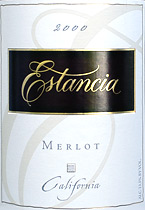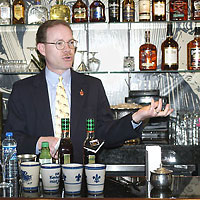|
A quick julep break Once in a great while, this column takes a rare detour from wine for a change-of-pace taste of other libations. And there's no better time for such a break than this joyous springtime season when my home town, Louisville, puts on its party clothes to celebrate the Kentucky Derby. Accordingly, prompted by a tasting-and-media-event in which I served as a judge last week, I hope you'll indulge me in a quick dissertation on the mint julep, a historic drink with a deep Kentucky connection. (If wine's your game and you prefer no exceptions, feel free to page on down to today's wine report. We won't do this again any time soon!)
Legend has it that Bourbon whiskey was invented in the late 1700s by a Baptist minister named Elijah Craig (whose name is still enshrined in the name of a popular brand); but in fact Craig was only one of many thirsty settlers who brought whiskey recipes with them from the East and produced potent liquor from the region's plentiful corn crop and sweet limestone water, storing it in sturdy barrels made from Kentucky oak trees. (As a matter of historical trivia, Craig didn't even live in Bourbon County, although his home was in the same rolling meadow region called the Bluegrass.) Modern Bourbon is distilled from a mix of grains that must include at least 51 percent corn (the rest may include rye, wheat and/or barley), and it is stored for at least two years in new, charred oak barrels that add to its distinctive sweet-caramel flavor. Since the barrels may be used only once, many of them are sold after use to distillers in Canada and even Scotland, where the natives make a well-regarded liquor of their own. (And to the dismay of many Kentuckians, who must feel much as do wine makers in Champagne who object to lesser brews bearing the local name, the law does not limit the name "Bourbon" to Kentucky-made liquor.) So what's a julep? The name goes back through Chaucer's English (where it meant "sugar syrup") and old French and Latin to the ancient Persian word "Gulab," which means "rose water." Variations of the name have been attached to sweetened alcoholic tipples in Britain, France and the U.S., but the modern "mint julep" has become a symbol of the Southern U.S. and specifically Kentucky. As with any old tradition, you'll find dozens of variations, most claiming to be the original. To make a long story short, the mint julep is a strong drink made with straight Bourbon (and plenty of it) flavored with sugar or sugar syrup and scented with fresh mint, served from a glass (or, most traditionally, a silver cup shaped a bit like a short tumbler) over plenty of cracked ice. A commercial version is sold at Churchill Downs, home of the Kentucky Derby, in a tall souvenir glass imprinted with the names of all the Derby winners since 1875, an item that is updated annually and has become a collector's item itself. Louisville television station WHAS-11 recently assembled a small group of purported experts, including your humble scribe, for a mint julep tasting hosted by Brown-Forman Corp., an old Louisville distiller that has grown into an international beverages conglomerate (with, coincidentally, a significant presence in the wine industry). Chris Morris, Brown-Forman's Bourbon expert, who will assume the company's Master Distiller post next year, put together five samples including such modern affectations as "The Jocuse" (a thoroughly non-traditional mix of Bourbon flavored with a splash of creme de menthe, lime juice and sparkling water) and the appalling "Mintini," a fluorescent green drink featuring Bourbon, green creme de menthe and sugar, shaken, not stirred, with ice and strained into a Martini glass garnished with a mint leaf. Better, for my tastes anyway, was the recipe created by Henry Watterson, World War I-era publisher of The Louisville Courier-Journal, who advocated carefully assembling the finest mint, sugar, ice and other fixings and then discarding them to enjoy the Bourbon alone. This procedure worked quite well using Woodford Reserve, a Bourbon produced at Brown-Forman's Labrot & Graham Distillery in the aforementioned Versailles. For a once-a-year julep treat, though, Morris's traditional recipe won my top rating: Put a few fresh mint leaves in the bottom of a glass or julep cup with a teaspoon of confectioner's sugar (not granulated sugar) and just enough water to dissolve the sugar. Mash (or "muddle") this brew with a wooden spoon handle, then fill the glass with crushed ice and pour in 2 1/2 ounces of Bourbon. Pack in more crushed ice ("just like making a snow cone," Morris joked), garnish with several sprigs of mint, and insert a straw cut short enough that you have to put your nose in the mint to reach it. Sip slowly from the bottom, so the straw pulls the Bourbon through the mint-and-sugar mix, and plan to contemplate it for at least an hour ... perhaps the late-afternoon hour on the first Saturday in May when the Derby is on the air.
WEB LINK: Labrot & Graham, a small, historic distillery that Brown-Forman restored and reopened recently, has a Website at
If you're in the Louisville viewing area, a segment about the julep tasting will be featured during a special Derby-season program, "Call to the Post," on WHAS-11 from 8 to 9 p.m. Derby Eve, Friday, May 2. WHAS-11 Website: And now, back to the wine ...  Estancia 2000 California Merlot ($13.49)
Estancia 2000 California Merlot ($13.49)
Dark garnet, almost black at the center. Appetizing cherry and dark-chocolate aromas lead into a ripe, juicy black-cherry fruit flavor shaped by crisp acidity. Not overly complex, but good balance and structure yield an approachable Merlot that fares well with food. (April 28, 2003) FOOD MATCH: Best with steaks or burgers, but proved a fine match with a meatless evening meal of scrambled eggs with sharp Cheddar melted in and a small side dish of spaghetti tossed with fresh arugula, butter and garlic. VALUE: Appropriate value at the $15 winery price, often found at local retail for less. WHEN TO DRINK: It won't fade in a year or two, but do enjoy it while its fruit is young and fresh.
WINERY WEBSITE: You'll find Estancia's fact sheet on the 2000 Merlot at WineCommune: Discover the Best Place to Buy and Sell Fine Wine, On-Line
WineCommune is an online community that connects wine buyers and wine sellers via the Internet. Through WineCommune tens of thousands of wine enthusiasts around the world buy and sell fine wines online. Established in 1999, WineCommune is now the largest wine auction and retail site worldwide. WINE BUYERS!
• Buying is FREE, no commissions charged to the buyer WINE SELLERS!
• The industry's most competitive commission rate – 3% on successful transactions only
Please come visit and browse around our wine community – we think you'll like what you see. California Wine Club: Leveraging the "wine glut" for consumers
"We are getting calls from wineries that in the past, we only dreamed of including in our club," says Club President Bruce Boring. "As this backlog of wine increases, so does our opportunity to bring our members some really incredible wines at great prices." But the wine glut also means an abundance of bulk wines. If a winery is dissatisfied with a wine, it may be sold to "bulk-wine distributors" to help offset losses. These distributors will then try to make a successful blend from these rejected wines, labeling them with a fictitious name and image and selling these "new wines" to grocery and wine stores. Unfortunately, California law does not require that this process be disclosed on bulk-wine labels. So how can consumers know whether they're getting the best that California has to offer? Lots of research helps, but who has time for research? More and more consumers trust their wine purchases to wine clubs. They are easy, convenient and often come with discounted prices for reorders. The California Wine Club offers a risk-free way for wine consumers to experience a wide range of quality wines from the best of California's boutique wineries.
For more information about California Wine Club, call 1-800-777-4443 or visit Sponsorship Opportunities
30 Second Wine Advisor sponsorships are limited to established wine-and-food-related businesses with a track record of customer service. For information about delivering your message to our 25,000 international readers, write Last Week's Wine Advisor Index The Wine Advisor's daily edition is usually distributed on Mondays, Wednesdays and Fridays (and, for those who subscribe, the FoodLetter on Thursdays). Here's the index to last week's columns:
• More Tuscans (April 25, 2003)
• Sub-Tuscan? (April 23, 2003)
• Holiday Potpourri (April 21, 2003)
• Complete 30 Second Wine Advisor archive:
• Last week's Wine Advisor Foodletter: Faraona arrosto (roast guinea hen) (April 24, 2003)
• Wine Advisor Foodletter archive: To subscribe or unsubscribe from The 30 Second Wine Advisor, change your E-mail address, or for any other administrative matters, please use the individualized hotlink found at the end of your E-mail edition. If this is not practical, contact me by E-mail at wine@wineloverspage.com, including the exact E-mail address that you used when you subscribed, so I can find your record. We do not use our E-mail list for any other purpose and will never give or sell your name or E-mail address to anyone. I welcome feedback, suggestions, and ideas for future columns. To contact me, please send E-mail to wine@wineloverspage.com All the wine-tasting reports posted here are consumer-oriented. In order to maintain objectivity and avoid conflicts of interest, I purchase all the wines I rate at my own expense in retail stores and accept no samples, gifts or other gratuities from the wine industry.
Monday, April 28, 2003 |







